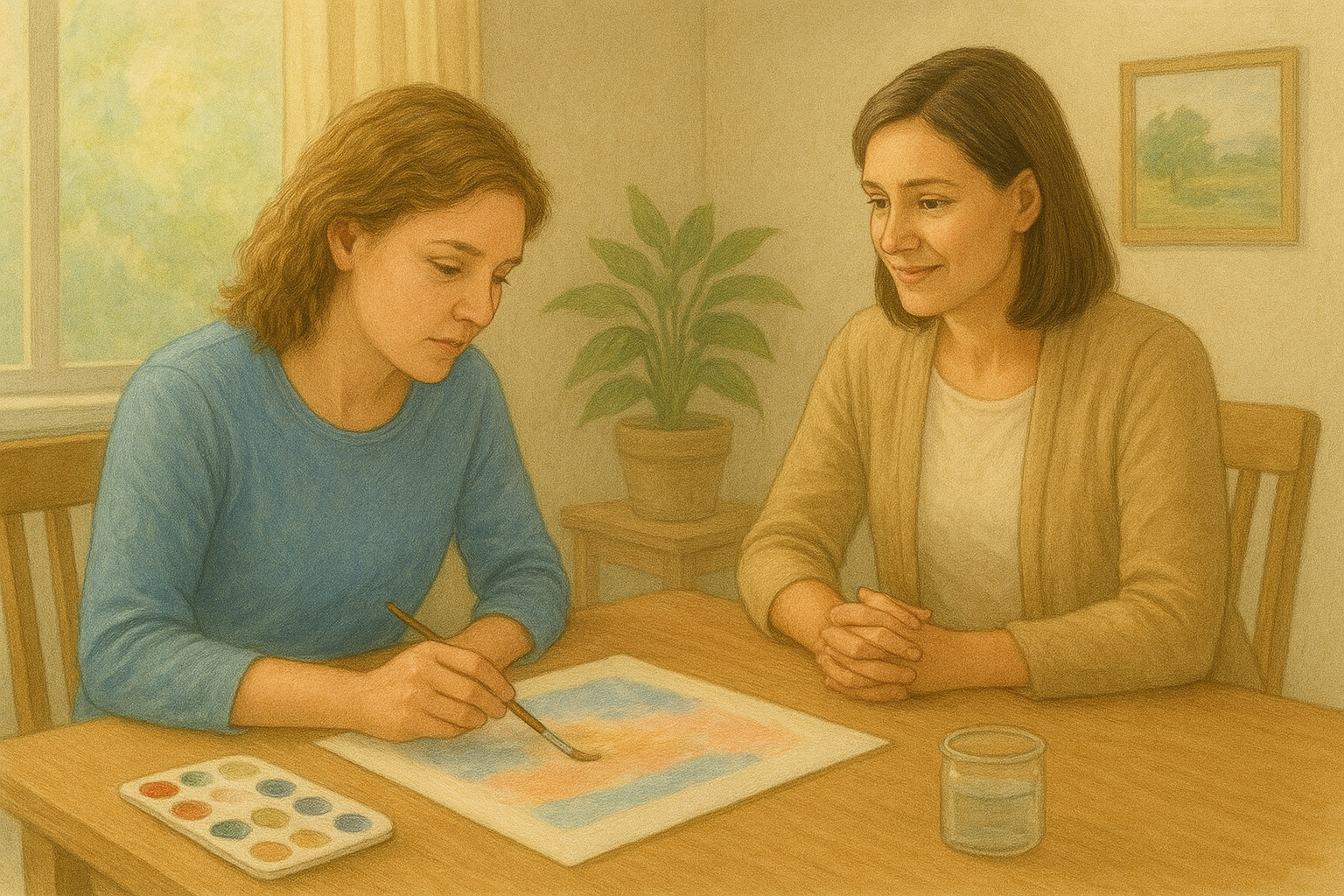Healing isn’t always about medication, diagnosis, or clinical procedures. Sometimes, the path to feeling whole again starts with something as simple as a paintbrush, a lump of clay, or a blank piece of paper. Art therapy is a powerful form of psychotherapy that uses creative expression to support mental, emotional, and even physical healing.
It’s not about being a skilled artist—it’s about allowing yourself to feel, express, and release. For those who struggle to find the right words, art therapy offers an alternative voice.
What is Art Therapy?
- Art therapy blends psychology with the creative arts. It involves the guided use of visual art—such as painting, drawing, sculpting, or collage—to explore emotions, build self-awareness, and process trauma. Sessions are led by trained, certified art therapists who provide both emotional support and structure during the creative process.
- The focus isn’t on how the artwork looks, but rather on what the process reveals. The very act of creating something allows individuals to externalize thoughts and emotions that may otherwise remain buried.
- Reference: American Art Therapy Association – official resource on the practice, methods, and benefits of art therapy.
Benefits of Art Therapy
1. Emotional Release
- We all carry emotions that don’t always surface in conversation. Art therapy provides a safe space for those feelings to emerge through imagery. Whether it’s grief, anxiety, anger, or joy, expressing these through art can be deeply cathartic and often brings a sense of relief or clarity.
- When emotions are hard to name, they can still be painted.
- Resource: Holistic Approaches to Well-being: Mind, Body, Spirit.
2. Stress Reduction
- The act of making art encourages mindfulness. Whether it's slowly blending colors, shaping clay, or focusing on details, art creation brings you into the present moment. This calming focus helps regulate your nervous system and lower stress hormones, much like meditation or deep breathing.
- Even a short session can lead to noticeable drops in anxiety and tension.
- Reference: Verywell Mind – How Art Therapy Works.
3. Trauma Recovery
- Trauma is often stored in the body and subconscious—making it difficult to express with words alone. Art therapy allows individuals to access and process these deep wounds in a gentle, non-verbal way.
- Through symbolic representation and creative exploration, survivors can begin to reclaim their stories, develop coping mechanisms, and work through painful memories with greater safety and support.
- Related read: Patient Advocacy: Ensuring Your Voice is Heard in Healthcare.
- Reference: NIH – Art Therapy and PTSD.
4. Boosting Self-Esteem
- There is a quiet but powerful satisfaction that comes from completing a piece of art. For someone struggling with low confidence or self-doubt, that sense of accomplishment can be transformative. It reinforces the idea that they are capable of creating something meaningful, beautiful, and deeply personal.
- The artwork becomes a mirror—reflecting not just feelings, but also strength, progress, and potential.
- Resource: Decoding Medical Jargon: A Simple Guide.
5. Improving Communication
- Not everyone is comfortable expressing themselves through language. For children, individuals on the autism spectrum, or people with social anxiety, art becomes a bridge to expression. Even abstract images can convey rich inner worlds, opening up new channels of communication with therapists, caregivers, or loved ones.
- In many cases, the artwork becomes the starting point for important conversations.
Who Can Benefit from Art Therapy?
Art therapy is adaptable and inclusive, supporting a wide range of individuals regardless of age, background, or condition. It’s especially helpful for:
- Children coping with developmental or behavioral challenges.
- Teens and adults experiencing depression, anxiety, or self-harm.
- Elderly individuals dealing with loneliness, memory loss, or the emotional effects of aging.
- People with chronic illnesses or physical limitations seeking an emotional outlet and improved quality of life.
- Survivors of trauma who need non-verbal methods of processing difficult experiences.
Whether used as a stand-alone therapy or alongside other treatments, art therapy has proven to be a highly effective, compassionate approach to care.
Reference: Psychology Today – Art Therapy Overview.
How Art Therapy Works in Practice
A typical art therapy session is more than just making art—it’s a guided journey of exploration. It usually involves:
- Choosing a medium such as drawing, painting, clay, collage, or mixed media.
- Creating intuitively or based on a therapeutic prompt. The focus is on what emerges, not on skill.
- Reflecting with the therapist. This may involve discussing what the art represents, what feelings arose during the process, or how the imagery connects to life experiences.
This creative-reflective loop helps individuals gain insight, process emotions, and build tools for healing and growth.
Why Art Therapy Matters
In today’s world, where stress and disconnection are increasingly common, art therapy offers a profound and much-needed alternative to conventional healing. It helps people reconnect with themselves in a meaningful, non-judgmental way.
It reminds us that healing is not just a clinical process—it’s deeply human, creative, and emotional.
By bringing art into therapy and healthcare, we unlock a powerful space where people can express what’s unsaid, process what’s unprocessed, and begin to move forward with more clarity and compassion.
Final Thoughts
Art therapy invites us to heal by creating. It asks us not to explain our pain, but to paint it, shape it, or draw it—and in doing so, transform it.
You don’t need to be an artist. You just need the courage to begin.
Whether you’re facing emotional struggles or simply seeking a new way to connect with yourself, art therapy offers a gentle, empowering path to wellness—one brushstroke at a time.
